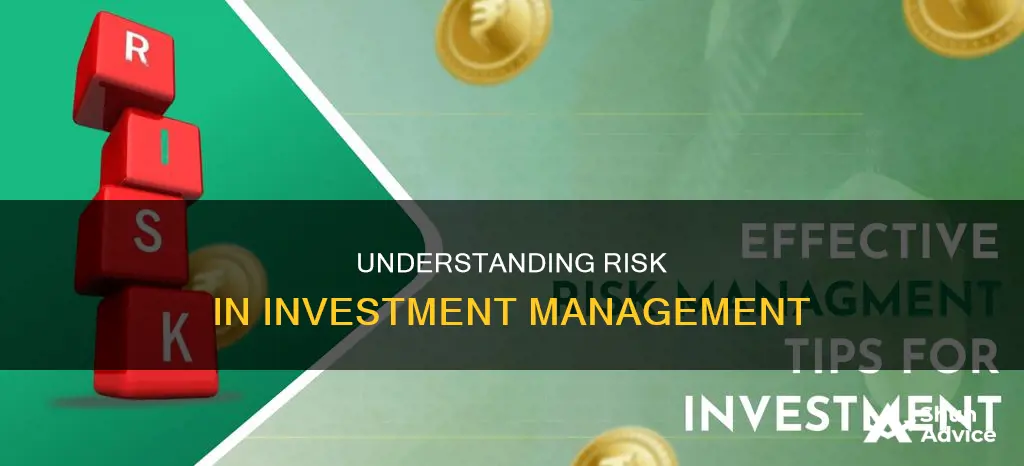
Risk is an inherent part of investing. It refers to the possibility of losing some or all of an original investment. In other words, it is the chance that an investment's actual return will differ from what was expected. Risk management is the process of identifying, evaluating and controlling these risks. It involves understanding the basics of risk, how it is measured, and the various strategies that can be employed to manage it. While risk cannot be completely eliminated, it can be mitigated through diversification, hedging, and other techniques. Successful financial risk management requires balancing potential risks with potential rewards.
What You'll Learn
- Risk is inherent in all investments, but it can be mitigated through diversification and hedging strategies
- Risk management is a process of identifying, evaluating, and controlling risk in a portfolio
- Risk management strategies include avoidance, retention, sharing, transferring, and loss prevention
- Risk can be quantified in absolute and relative terms, with standard deviation being a common metric
- Different types of investments carry different levels of risk, and thus require distinct strategies

Risk is inherent in all investments, but it can be mitigated through diversification and hedging strategies
Risk is an inherent part of investing, and it refers to the chance that an investment's actual gains will differ from the expected outcome or return. This includes the possibility of losing some or all of the original investment. While risk cannot be avoided, it can be managed and mitigated through various strategies.
All investments carry some level of risk, but the amount of risk varies depending on the type of investment. For example, a fixed deposit is considered a less risky investment, while equity investments are generally riskier. When making investment decisions, it is crucial to identify, evaluate, and address these risks through a risk management plan.
One effective strategy to mitigate risk is diversification. By diversifying their portfolio, investors can reduce their exposure to risk. This involves investing in different companies, sectors, and regions, as well as including a mix of higher- and lower-risk investments such as equities, bonds, property, or cash. Diversification helps to make the portfolio's performance more consistent, as different types of investments respond differently to economic situations and will rise or fall in value at different times and rates.
Another strategy to consider is hedging. Hedging strategies, such as using derivatives, can help investors manage and reduce their exposure to specific risks. For example, investors can use financial instruments like options and futures to offset potential losses in other investments. Additionally, investing in dividend-paying stocks with a history of regular increases can provide a safeguard against inflation risk.
It is important to note that risk management is a continuous process as risks can change over time. Individuals should periodically review the level of risk in their portfolio and make adjustments based on their age, goals, and risk tolerance. By understanding the basics of risk, how it is measured, and the strategies available for managing it, investors can make more informed decisions and improve their potential returns.
Understanding Minimum-Variance Portfolio Investment Proportions
You may want to see also

Risk management is a process of identifying, evaluating, and controlling risk in a portfolio
Risk management is a crucial process in investment, as it helps investors make informed decisions and balance the potential risks with the potential rewards. It involves identifying, evaluating, and controlling the risks associated with a portfolio of investments. Here are some key aspects of risk management:
Identifying Risk
The first step in risk management is to identify the potential risks involved in an investment decision. This includes assessing the financial risks, such as high inflation, volatility in capital markets, recession, or bankruptcy. By understanding these risks, investors can make more informed choices about their portfolio allocations.
Evaluating Risk
Once the risks have been identified, they need to be evaluated to determine their potential impact on the investment portfolio. This evaluation involves analysing historical behaviours, outcomes, and volatility. Metrics such as standard deviation, beta, and alpha are commonly used to assess the risk associated with a particular investment. Standard deviation measures the volatility of asset prices compared to their historical averages, while beta measures the volatility of a stock relative to the overall stock market. Alpha, on the other hand, measures the risk-adjusted performance, indicating whether the return exceeded or fell short of the expected risk.
Controlling Risk
After identifying and evaluating the risks, the next step is to implement strategies to control and mitigate those risks. Diversification is a key risk management strategy, where investors spread their investments across different companies, sectors, and regions. This helps reduce the impact of specific risks associated with individual companies or industries. Another strategy is the buy-and-hold approach, where investors ride out short-term market fluctuations and focus on long-term gains. Additionally, investors can adjust their asset allocation based on their age and risk tolerance, with younger investors typically adopting more aggressive strategies and older investors shifting towards more conservative investments as they near retirement.
Monitoring and Adjusting
Risk management is an ongoing process, and investors need to continuously monitor their investments and make adjustments as necessary. This may involve rebalancing the portfolio to ensure it aligns with their financial goals, risk tolerance, and the changing market conditions. Regular "check-ups" or rebalancing help investors maintain a risk level consistent with their financial strategy.
Importance of Risk Management
Effective risk management is essential as it helps investors achieve their financial goals while minimising potential losses. It provides a framework for making investment decisions, allowing investors to balance risk and return. By understanding and managing risk, investors can improve their decision-making process and maximise the potential for long-term gains.
Understanding the Portfolio Investment Process: A Comprehensive Guide
You may want to see also

Risk management strategies include avoidance, retention, sharing, transferring, and loss prevention
Risk is an inherent part of investing, and risk management is a crucial aspect of investment management. It involves identifying, assessing, and controlling threats to an organisation's capital, earnings, and operations. Effective risk management helps investors achieve their goals while offsetting potential losses.
There are several risk management strategies, including avoidance, retention, sharing, transferring, and loss prevention:
Avoidance
Risk avoidance involves eliminating hazards, activities, and exposures that can negatively impact an organisation and its assets. While complete risk elimination is rarely possible, avoidance strategies aim to deflect as many threats as possible to avoid costly and disruptive consequences. For example, a company may halt construction work during an electrical storm to prevent the risk of accidents.
Retention
Retention involves acknowledging and accepting certain risks. This strategy entails accepting the possibility of losses as a trade-off for the potential of higher returns. Investors who choose riskier investments, such as stocks, expect higher returns to compensate for the increased risk.
Sharing
Risk sharing involves distributing risk among two or more parties. For instance, insurance companies may pay reinsurers to cover potential losses above specified levels. Employer-based health insurance is another example, where the company shares the risk by paying a portion of the insurance premiums.
Transferring
Risk transferring involves passing risks from one party to another. Health insurance is a common example, where individuals transfer the risk of expensive medical costs to an insurance company by paying regular premiums.
Loss Prevention and Reduction
Rather than eliminating risk, loss prevention and reduction strategies focus on minimising potential losses. Investors may balance volatile investments with more conservative choices to reduce overall risk. Diversification is a key strategy, where investors spread their investments across different industries and asset types to reduce exposure to specific risks.
Understanding Your Investment Portfolio Report: A Guide
You may want to see also

Risk can be quantified in absolute and relative terms, with standard deviation being a common metric
Risk is an inherent part of investing, and it is important to understand how it can be quantified to make informed investment decisions. Risk can be quantified in both absolute and relative terms, and standard deviation is a commonly used metric for this purpose.
Standard deviation is a statistical measure that helps to determine the volatility of an investment's returns by calculating the dispersion of data points from their mean. In the context of investing, it reflects how much an investment's returns deviate from their historical average over a given time frame. A high standard deviation indicates that the investment's returns are highly volatile and unpredictable, while a low standard deviation suggests that the returns are relatively stable and less risky.
When assessing risk, it is essential to consider the investment's average return alongside its standard deviation. By comparing the standard deviation to the mean, investors can gain insights into the potential range of outcomes and make more informed decisions. This comparison allows investors to determine the likelihood of an investment's returns falling within a certain range, helping them assess the level of risk associated with that investment.
Standard deviation is particularly useful for comparing the volatility of different investments and making informed decisions about portfolio construction. By considering the standard deviation of various investments, investors can diversify their portfolios by including a mix of assets with varying levels of risk. This diversification helps to balance the overall risk of the portfolio, as it ensures that not all investments are subject to the same volatility and potential losses.
In addition to standard deviation, there are other methods for quantifying risk, such as beta, value at risk (VaR), and conditional value at risk (CVaR). These tools provide investors with a comprehensive understanding of the potential risks associated with their investments, enabling them to make more informed decisions and align their portfolios with their risk tolerance and financial goals.
Creating Your First Investment Portfolio: A Beginner's Guide
You may want to see also

Different types of investments carry different levels of risk, and thus require distinct strategies
Different types of investments carry different levels of risk and, as such, require distinct strategies. Risk is inherent in all investments, and successful financial risk management requires balancing potential risks with potential rewards.
The level of risk an investor is willing to take is determined by their risk profile, which takes into account factors such as personality, lifestyle, and age, as well as income, investment goals, liquidity needs, time horizon, and personality.
There are several types of risk, including systematic and unsystematic risk. Systematic risks, also known as market risks, affect an entire economic market or a large percentage of the total market. They include political risk, macroeconomic risk, interest rate risk, inflation risk, currency risk, liquidity risk, country risk, and sociopolitical risk. These risks are challenging to mitigate through portfolio diversification.
On the other hand, unsystematic risk, also known as specific or idiosyncratic risk, affects only a particular industry or company. Examples include changes in management, product recalls, regulatory changes, and new competitors. Investors often use diversification to manage this type of risk by investing in a variety of assets.
Other specific types of risk include business risk, operational risk, credit or default risk, country risk, foreign exchange risk, interest rate risk, reinvestment risk, political risk, counterparty risk, liquidity risk, and model risk.
To manage these risks, investors can employ various strategies such as diversification, hedging, and derivative positions. Diversification is a fundamental strategy that involves spreading investments across different asset classes, industries, and geographic regions to reduce overall portfolio risk. Hedging involves using financial instruments like options and futures to offset potential losses. Derivative positions can also be used to manage risk by entering into contracts whose value is based on an underlying asset.
Additionally, there are several risk management techniques that can be employed, including avoidance, retention, sharing, transferring, and loss prevention and reduction. Avoidance involves eliminating risk by choosing the safest assets. Retention accepts risks in pursuit of higher returns. Sharing involves transferring risk to another party, such as through insurance. Transferring involves passing risks to another party, such as through health insurance. Loss prevention and reduction involve mitigating risk by balancing volatile and conservative investments.
It is important to note that higher-risk investments do not always equate to higher returns, and there are no guarantees. However, by understanding the different types of investments and their associated risks, investors can develop distinct strategies to manage their risk exposure and work towards achieving their financial goals.
Managing Multi-State Investments: A Comprehensive Guide
You may want to see also
Frequently asked questions
Risk in investment management refers to the chance that an investment's actual gains will differ from an expected outcome or return. It includes the possibility of losing some or all of an original investment. Risk is inherent in all investments and cannot be avoided, but it can be managed and minimised.
You can identify and assess the risks associated with your investments by understanding the basics of risk and how it is measured. Quantifiably, risk is usually assessed by considering historical behaviours and outcomes. Standard deviation is a common metric used to assess risk, providing a measure of the volatility of a value in comparison to its historical average.
There are several ways to manage and minimise investment risks, including:
- Diversification: Holding a well-diversified portfolio of securities across different companies, sectors and/or regions can help reduce investment risk.
- Risk management strategies: This includes techniques such as avoidance, retention, sharing, transferring and loss prevention/reduction.
- Long-term investing: Financial markets can experience short-term turbulence, so investing for the long term (minimum five years) can help smooth out the peaks and troughs.
- Regular investing: Buying at regular intervals can lower the average price you pay and help smooth out the peaks and troughs over time.







